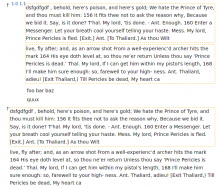Currently, the code of reference item in reference list is:
<li id="cite_note-1"> <span class="mw-cite-backlink"><a href="#cite_ref-1">↑</a></span> <span class="reference-text">Lorem ipsum.</span> </li>
This is wrong, because it disallows block elements in references. (In fact, if one puts the block elements there, they are being converted by Tidy in very unpredictable way.)
The easiest solution is to remove the <span class="reference-text"> wrapper.
Whiteboard: usability
